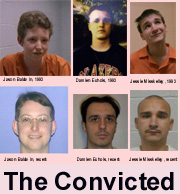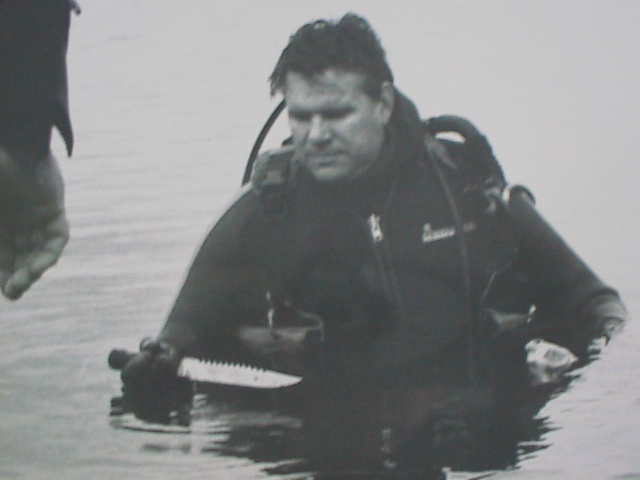
Discovery of the Lake Knife by Officer Joel Mullins, November 17, 1993. E169
My name is Gary Gitchell and I am an inspector of the criminal investigative division of the West Memphis Police Department. I decided to search the lake based upon a suggestion that Mr. Fogleman made if I had thought to do that or not. And based on his suggestion, we did that. But, it was not based on any Crimestopper's tip. [Gary Gitchell, Echols/Baldwin trial abstract]
. . . Gary Gitchell said his department has wanted to do a search of the lake for several months, but this is the first opportunity they had to do it. [November 18, 1993, West Memphis Evening Times]
The Lake Knife
In spite of having entered sixteen knives into evidence, six months after the murders the prosecution did not have one to present as a murder weapon. This changed with the discovery of a knife in the lake next to the residences of Jason Baldwin and Domini Teer.
On the morning of November the 17th, the police received the permission of Lakeshore resident James Ellison to use his property as a launching pad to search the lake. Shortly after the search began, diver Joel Mullins of the Arkansas State Police found a survival knife eight feet underwater, its nine-inch blade stuck in the lake bottom.
Mullins: It, um - like the pier itself as I recall, runs pretty much at a 90 degree angle straight away from the shoreline out toward the water and then if you just extended that straight on out um - uh - another, I guess it'd be 30 or 35 feet out from the end of the pier, straight on out, that's where the knife was. [Echols/Baldwin trial testimony]
He described it as being located 47 feet offshore, almost directly behind the trailer of Jason Baldwin. The map below was entered into evidence to define the discovery site.
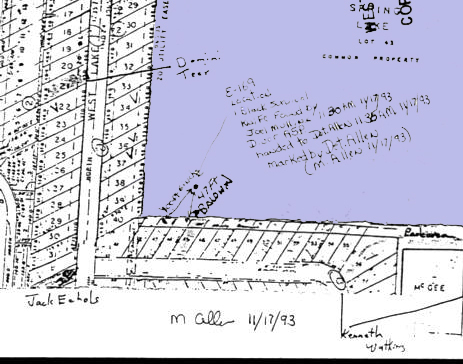
Spring Lake in the Lakeshore area.
Trailer lots are numbered.
Although the prosecution had found a knife in the vicinity of the home of Jason Baldwin, there was nothing yet that connected it to the defendants or the crime. No trace evidence was found on the knife, but two witnesses would provide very different stories that connected such a knife to the defendants.
The first to step forward was, yet again, Jason Crosby. On November 18th, the day after the discovery of the Lake Knife, Jason Crosby made a statement to the police wherein he said he had a knife stolen from him about one year in the past. He said he confronted Jason Baldwin about stealing the knife and said Jason told him he had traded the knife and a trench coat to a relative for a bicycle. The knife was in many ways similar to the Lake Knife. He described the knife as about 14 inches long, with a black handle and a screw cap and a small storage compartment. It was said to have a hump or curve in the blade and had the brand name "Fury" on the blade next to the handle.
Deanna Holcomb, the ex-girlfriend of Damien Echols, stated that Damien had owned a similar knife. "About E-169 that reminds me of a knife that Damien had was the ridge edge and the handle, the end part of the handle. The shape of the blade. Damien had it around October of 1991, in a trinch coat." Deanna Holcomb statement, 2-14-94.
She went on to testify at the Echols/Baldwin trial:
Davidson: Now, let's go back to this large knife. Where did you say that it was when you saw it?
Holcomb: In his trench coat pocket. [Echols/Baldwin trial]
James Parker, son of the owner of Parker Cutlery in Chattanooga, Tennessee, testified his company sold a similar knife through their catalog. Theirs had a compass in the end of the handle. In cross-examination by defense attorney, Val Price, he said:
Price: Alright, but did Parker Cutlery actually manufacture the knife or just distribute it?
Parker: No sir - no sir, they distributed a knife like that one. They might not have even distributed that same one.
Price: Ok.
Parker: It's a generic style knife. [ibid]
Echols later testified that he had a similar but different knife.
Echols: Not that knife, no. . .I had one sort of like that, but mine didn't have a black handle. The handle on mine was camouflaged, and it had the camouflage case and everything. The blade on mine was black. It wasn't silver like that. [ibid]
Although the Lake Knife played a prominent role in the Echols/Baldwin trial, it played no role in the Misskelley trial. In his confession, Misskelley had specifically described the murder weapon as a six-inch fold-up knife. In the Echols/Baldwin trial, the defense counsel could not refer to the Misskelley confession to impeach the significance of the knife.
Is finding such a knife unrelated to the murders near the Baldwin residence so improbable? Three knives were recovered from the area near where the children were found and none was linked to the crime. What could have been the source of the Lake Knife? Interestingly, Baldwin's neighbors had secrets. Anthony Hollingsworth and James Ellison would later be registered as sex offenders, and, living two doors down from the Baldwins, was "George Cook," aka John William Childers.
John W. Childers, born 4/21/1932, fled from his trailer home in North Ft. Myers, Florida after murdering his common-law wife, Laure Catherine Green, on November 6, 1983. She was killed by blows to the head with a hammer. Her body was found dumped in a septic tank and a claw hammer and a meat cleaver were found nearby. Months later he appeared in Memphis and met a Barbara Hay at a dancehall called Bad Bob's Vapors. Childers, at that time going by the name, George Cook moved in with Barbara Hay in 1986 and they lived together in the Lakeshore area of Marion, Arkansas, running a business with 20 trailers.
America's Most Wanted ran several broadcasts featuring him and his crime. A fifth broadcast in November 1993 (shortly before the lake was searched) led to a tip from a neighbor dated November 16 stating that Childers lived "in West Memphis." The newspaper accounts say he was brought to the police station where he was questioned and fingerprinted. Before his prints could be correctly matched, he skipped town. He was eventually arrested in Jacksonville, Florida in April of 1994. He was sentenced on October 18, 1996 to life in prison. [sources for information on Childers are: Memphis Commercial Appeal, April 19 and May 4, 1994; Childers appeal, John W. Childers vs. the State of Florida, May 9, 2001, Florida Department of Corrections website, and Matthew Baldwin.]
A recent twist in the saga of the lake knife has appeared in the recent court filings. In the 2008 Writ of Coram Error Nobim by the attorneys for Jason Baldwin, they state "... post-conviction investigation has revealed that at least two witnesses [Domini Teer and Garrett Schwarting] told the police that they were aware that a large knife was thrown into the lake before the murders. Also, one of the law enforcement dive team has indicated the officers were given precise directions on where to find the knife." In this writ, the attorneys for the defendant argue that witholding this evidence comprised prosecutorial misconduct.
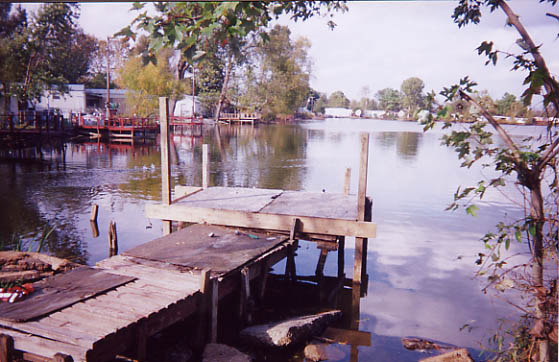
The pier in the back of Jason Baldwin's trailer.
The Knives and the Wounds
The medical examiner, Dr. Peretti, was not able to narrow down which sort of knife inflicted the wounds. After having identified the serrated edge of the Lake Knife as a possible source of some scraping wounds on the children, he was cross-examined by defense attorney Paul Ford.
Ford: So what you're saying is, based on the elasticity of skin just about any serrated edge could cause it, couldn't it?
Peretti: Well, if um - one with a very fine serration, I think you can rule out - a very, very fine serration. But um - most serrated knives - depending on the position of the deceadant, the elasticity of the skin can cause those type of serrated um -
Ford: - So, most serrated knives could cause this injury? Most serrated -
Peretti: - No, I think we can rule out a butterknife ok, a serrated butterknife.
Ford: Ok, but most serrated knives can cause it?
Peretti: Yes. [Echols/Baldwin trial]
These pronouncements became even more equivocal:
Ford: Is that your opinion based upon a reasonable degree of medical certainty that in your opinion that injury was caused by a serrated knife?
Peretti: Well, it may be caused - it may be caused by another instrument also. But it has the appearance - you know, of the distance. If you look at it there is a pattern to it, but it may be caused by another object also. [ibid]
And:
Ford: But anything could have caused it, you don't know what caused that injury - anything? I'm asking, do you know what caused that injury?
Peretti: No. [ibid]
Later, regarding the gouging injuries:
Peretti: The um - the facial injuries.
Ford: Ok. In what - in what photograph number?
Peretti: I'm sorry, um - 71B, um - 72B, 63B, 62B -
Fogleman: - Your Honor, so we don't get bogged down, I'd understood earlier that uh - that Dr. Peretti had said that a regular edged knife could cause those injuries, too. Is that - did I misunderstand that?
Peretti: Yes, sir. A regular um - a straight edge knife can also cause these type injuries.
Ford: So there's nothing peculair about this knife that would cause those facial injuries?
Peretti: No.
Ford: Any knife in the world could cause those?
Peretti: That's correct. [ibid]
Peretti then went on to say it might not have been a knife at all:
Peretti: Well, we generally see these types of injuries with an object such as a knife or piece of glass, a sharp object was put into the skin and either the person doing the - the um - stabbing, is twisting and pulling the knife or a combination of the person being stabbed - I mean, that skin's soft so if you move around or moving the knife with a twist, the knife is going to cut it out - it's going to pull out the soft tissues of the skin. [ibid]
Although Peretti seemed unwilling to link the wounds to a specific source, Fogleman did not share his uncertainty. In his closing arguments, Fogleman used a grapefruit to perform a dramatic demonstration of the pattern of wounds made by the Lake Knife.
Fogleman: . . . a knife like this [the Lake Knife]--not like that other knife [the Kershaw knife], but a knife like this, with this serration pattern caused the injuries--some of the injuries to Chris Byers.
The defense objected.
Ford: ... that grapefruit is not in evidence. This demonstration is not in evidence. It's not scientific, it's not reliable. [snip] That's improper Your Honor, that's a demonstration and experiment.
Burnett: Well I'm gonna allow it.
This demonstration became part of the appeals. "We had a representative of the State hold up a grapefruit as an analog to human flesh. Our filing in federal court says that the analog of a grapefruit to human flesh being cut is like comparing cutting chalk to cutting cheese. It's a fraud. It can't be done. [snip] It's a classic instance of prosecutorial misconduct, in attempting to inform a jury of facts that are unbased in the evidence. It is a federal Sixth Amendment right violation, it is a critical claim in front of the federal court right now." [Dennis Riordan, Damien Echols Legal Defense Team Press Conference - November 1, 2007] Forensic odontologist Dr. Richard Souviron was equally vehement. "That is the most ridiculous statement that I've ever heard anybody make. And to sell that to a jury is unconscionable, in my opinion." [Dr. Souviron, ibid]
Was there ever a knife?
As part of their re-examination of evidence in the appeal of this case, the defense team of Echols and Baldwin have brought together a formidable collection of medical forensic experts with decades of experience, authors of the standard textbooks in the field of forensic pathology. This group included forensic pathologist Drs. Werner Spitz, Michael Baden, Vincent Di Maio, Richard Souviron, Terry Haddix and Robert Wood. "The consensus reached by all of those experts was again, that most of the injuries to the skin of the victims, including the severe genital injury to Christopher Byers, were not caused by the use of a knife but by animal predation that occurred after death." [November 1, 2007 Legal Defense Team Press Conference.] Dr. Spitz was more emphatic. "None of the injuries were caused during life, and none were caused by a serrated knife, or any knife for that matter. These are not sharp injuries that have characteristics, and those characteristics are not identifiable or synonymous with a knife or any other sharp force type injury. . . I couldn't understand what this issue was all about because it was so obvious that these are animal product." [Dr. Werner Spitz, ibid]
Continued in Knives, Part Three, The Kershaw Knife
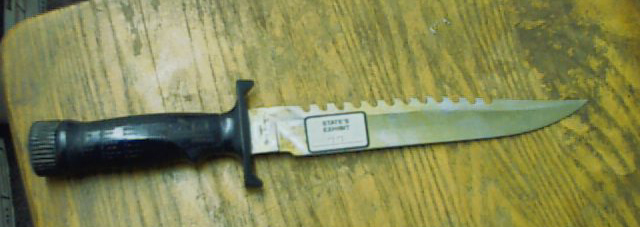
The "Lake Knife." |







